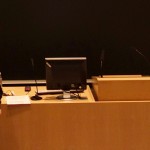Learning how to grow responsibly: Enel’s development

To grow as a company is the goal every manager envisages and, by taking into account today’s trends, this involves more than simply looking at the return on investments. Companies cannot spearhead their way into blind expansion, especially when aspects such as social, or environmental responsibility are often enough considered more important than any financial gains one might attain.
One example of a company that has managed to successfully grow, both in terms of performance and responsibility is Enel, Italy’s largest energy supplier and a leader in power and gas markets in over 30 countries.
They achieved this by creating a relationship model between themselves and their clients. The system itself is not complicated at all: they simply build upon the communities where they want to operate new power plants.
First off, each of their projects takes notice of all socio-economic and environmental characteristics of a specific area of interest. Afterwards, a series of transparent and rigorous discussions are shared between the Enel and the communities’ representatives, in order to establish the priorities of both parties.
Any issues and priorities highlighted as being paramount, by each specific group, are given the utmost attention, so as to smooth out any rough patches and miscommunication, while the project is steadily getting underway.
This procedure of keeping an open relationship between Enel and its stakeholders is quite a common technique for the power supply company. Other such cases are the “EGP listens to you” program from Mexico (EGP stands for Enel Green Power, a subsidiary of Enel), the 20-year old cooperation plan signed in Guatemala and the work groups set up in Costa Rica.
With these in mind, Enel is well on its way to achieving two of the United Nation’s Millennium Development Goals: ensuring environmental sustainability and building partnerships for increased development.

So as we can see, Enel has continuously grown its consumer base, whilst maintaining two very important aspects: their profitability – ergo financial performance, and reputation – social and sustainability performance. So how did they successfully achieve this?
For starters, they managed to successfully implement a sustainable worksite model, namely a power plant design that takes into account the needs and requirements of local communities. Here are a few elements:
- Use of low environmental impact materials and components, such as biodegradable oil, environmentally-friendly paints, and recycled material.
- Use of resin transformers and mechanical removal equipment, which do not use oil.
- Maximization of percentage of drainage area in order to facilitate the ground penetration of rainwater.
- Environmentally-friendly management of the worksite and of waste, maximizing the % of waste being sent back for recycling purposes
- Reduction in emission of climate-changing substances, such as carbon dioxide and Sulphur hexafluoride.
- Containment of the area occupied by the worksite buildings, managing to protect any valuable local vegetal species.
- Energy procurement for the worksite from renewable energy sources, via reduction of raw materials usage and an increased presence of zero-emissions cars.
- Control and monitoring of all activities undertaken and the environmental indicators, examples here being measurement of emissions and CO2, percentages for waste recovery etc.
- Transfer to local communities of structures or machinery used at the worksite. Any huts, generators, batteries, steel and photovoltaic panels get handed over to the local groups after a project is completed.
Further on, Enel has implemented multiple other managerial procedures such as relocation programs, to stand as proof for their continual business growth. Often times, power plant construction sites require part of the people from the community to relocate, because the land currently housed is suitable for building purposes; however, this is where Enel shined again.
Chile, Neltume – Enel, through its subsidiary, Endesa, had to undergo numerous meetings and consultations with the local community before starting any building proceedings, since the land on which their future hydroelectric plant was going to be built on was, and is still, considered a “ceremonial ancestral site.”
As a result, instead of simply waltzing in and erecting their plant, 15 meetings were held even before the indigenous consultation process started. These were followed by 17 plenary meetings, 13 meetings for training and information-giving purposes, 4 meetings for community decision-making and 7 open meetings with representatives from Endesa Chile, the management of the EAS of the Region of Los Rios and the affected communities’ leaders.
Chile, Alto Biobio – in 2000, Endesa Chile began a relocation program for flood-affected families in the Ralco basin area.
As a result, 81 families from the Ayin Mapu and El Barco areas were moved out and the troublesome area of Ralco basin was given to Endesa to build their power plant on.
Furthermore, this specific project had to upkeep the agreements reached in the clauses regarding environmental approval (RCA 10/97). This meant that Enel had to implement, through its subsidiary, the following: study grants for middle and high schools, access to training and apprenticeship programs with study grants linked to the stay, implementation and enhancement of relations with the government to manage social issues and a program for the development of indigenous communities.
Chile, Bocamina – a second, thermoelectric plant was in store for the region of Bocamina, this one in the Municipality of Coronel, scheduled for early 2008.
It began operating in 2012, but 2013 came with seven “Recursos de Proteccion” from opponents of the project, such as local fishermen who argued that local underwater fauna is being threatened by the plant’s activities.
In November, 2014, an agreement was sought out and reached between Endesa’s representatives and those of the local communities, with 4 main points to be fulfilled by the former:
- Environmental improvements be made at Bocamina II;
- Further relocation efforts for families living close to the plant;
- Funds for the development of the Coronel community, with a transparent procedure for obtaining them and an increased role for local people and organizations;
- Funds to support fishermen, which were the most affected group.
Colombia, El Quimbo – being the most important electricity project in this country, Emgesa – Enel’s subsidiary from Colombia, started a series of discussions, offering the local populace to choose one out of two options, whichever one would be most suitable for them: individually/collectively relocate, or sell their land.
As of yet, the process is still ongoing, but there are some noteworthy details. 15 families have been relocated to the area of Santiago and Palacio at the start of 2014, where the first collective accommodation was built, with new homes, boasting all essential services and located in an urban area, with schools, a community center, a multifunctional sports center and many green areas.
By the end of the year, another 19 had been moved. The latter ones have also received technical support for agricultural production process implementation, livestock to start a business with and psychological help, to aid with adjusting to the new context. For 214 other families who refused relocation, the company has offered compensatory payments.
What’s more so, Emgesa helped out the people who used to run a business in the area, also giving them financial compensations.

After all these plans were laid out, Enel went even further. At the end of 2013, they released a qualitative and quantitative survey for their stakeholders: 11 countries, 3.965 valid stakeholders, cca. 700 interviewees, 10.2000 interviewed citizens, 54 country-tailored questionnaires, over 20.000 letters of endorsement for each stakeholder.
The main areas targeted were the future of the company, the economic and social impact large companies have on a country, the role of energy in sustainable economic development and how to improve Enel’s communication channels. In addition, the survey also had questions on which are the most critical areas of improvement and how it should enhance its sustainability efforts.
Coming to a close, it is not hard to see why Enel is such a successful company. By constantly engaging its customers and stakeholders, Francesco Starace, Enel’s CEO, has managed to create an increasingly performant business, which at the same time remains loyal and responsible to its clients.
Enel has maintained itself on the up and up in financial figures and continuously expands the number of power plants, building relationships wherever it sets foot.
In an age when pioneering is all the rave, this Italian company keeps its competitors on their toes, by respecting their clients and garnering a deep and loyal connection with them. This, in turn, creates demand; demand creates profit and so you have the best of both worlds, socially and economically.

Tags: Customer Satisfaction, Growth performance, Sustainability performance





